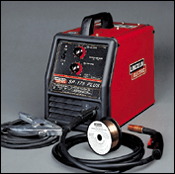
Lincoln SP-175+ MIG Welder
I chose this welder for several reasons:
- Continuous voltage control
- Wide current range (25-175A) handles 24ga up to 5/16"
- Comes with a gas regulator suitable for Argon/CO2
- Available stainless/aluminum kit
- ...and the number one reason: it's the official welder of NASCAR
and it comes with a sticker to prove it (mysteriously missing on the
illustration at left).
I compared
the SP-175+ to a few other machines:
- vs several 115v welders, especially the
Millermatic 130XP which seems to be the most highly
recommended. I decided I had 230V available (with a little wiring) and
would eventually crave the additional power. It's nice to be comfortably
within a 30A 230V circuit rather than about to trip the breaker on a
15A 115v circuit.
- vs
Miller Challenger 172
. I very nearly bought this machine. It's
about $100 less but doesn't include a gas regulator. The deciding factors
were: 4 discrete voltage settings on the Miller, and a current range
of 40-170A, which I was worried might be too hot for joining wire and
thin sheetmetal. It's also 20lbs heavier than the SP-175+.
- vs
Millermatic 185.
I've used one of these and they're very nice.
You can get the
Spoolmate 185 for welding Aluminum for about $450.
It can weld 3/8" in a single pass, which is only 1/16th thicker than the
SP-175+ (though admittedly that's probably with solid wire rather than
fluxcore). At $1000 it is $300 more than the SP-175+, which is a lot
to pay for wheels, which is about the only feature I'd be using in the
short term.
- vs
Lincoln SP-170T.
This unit is very similar in price and performance to the SP-175+. The
main difference is that is has 5 taps instead of continuous voltage control.
It's also 1lb lighter and has a slightly narrower current range.
Maybe this will go on clearance soon and be a better value.
What I Like
Several things discovered after I bought it:
- Lincoln has excellent service. The regulator that mine came
with had bent stems (probably due to abuse by the distributor, who had
unpacked it to get the serial number and then kind of piled it back into
the box). The flow meter was sticking so I emailed Lincoln the day after
I got it and they sent me a new one overnight that same day.
- The "suggested settings" table in the manual and inside the door are
usable (an older Lincoln Powermig 255 always seemed to lead me astray).
- The reversible drive roll will feed .023 to .035 wire. Another part
that I won't be losing.
- At 60lbs it is fairly light for a MIG welder. Still needs a cart though!
- Setup was quick and was mostly wingnuts.
- Good manual
I think I like the "automatic burnback" feature which it inherited
from the SP-170T, but it does tend to leave a ball of metal on the end
of the wire every time you stop welding.
Minor Complaints
Nothing has made me regret my purchase, but there are a few minor nits:
- During setup the (electrically hot) thumbscrew which secures the whip
can end up perilously close (under 1/4") from the negative electrode
thumbscrew. I had to cinch down the electrode lugs to get the wings away
when the connection was tight.
- The fan is on the entire time the welder is on, rather than waiting until
the welder gets warm. It's not loud, but I didn't expect it. On the
other hand, I've never forgotten to turn it off...
-
The threaded gas cup is slower to remove for cleaning than a slip-on cup,
and if you were careless with your MIG pliers you might damage the seal,
which is part of the gas cup rather than the gun assembly. You can't
adjust it back and forth (eg for getting into tight fillets). They do
make a gasless "cup" for fluxcore.
- The included cord ends in a NEMA 6-50P (a giant plug with the proportions
of a regular 3-prong 115v plug). This isn't a dryer plug. About the only
shop tool that is likely to have a similar plug is a kiln.
I lopped it off and replaced it with a NEMA L6-30P, which is a 30A twist-lock.
Additional Costs
You could weld with just what's in the box, if you want to do fluxcore,
and you don't have much to weld (only a 2lb spool included). You'll
probably want to buy a few spools of wire (about $1/lb, an 8" spool
of mild steel weighs 11lbs) and a gas tank.
I had to extend my dryer circuit about 1.5' to put a 230V outlet in the
garage. I did it myself, and with inspection and parts it cost me about
$60. If you need to do this make sure you know what you're doing and
get the permit (about $40 where I am) so that if your welder burns your
house down it's not plugged into an uninspected outlet that your insurance
company will use as an excuse not to pay the claim. Main thing to keep
in mind is that an older dryer will be hot/hot/neutral and the welder
wants hot/hot/ground. Pay an electrician if you are unsure.
I replugged for NEMA L6-30, including the welder, the new outlet and a
30' 10ga extension cord. The single most expensive part was the receptacle
end for the extension cord, which was $32! The 10/3 extension cord wire
was about $1/foot. You could do it cheaper by just replacing the cord on
the welder (save about $45 on the extra plug/inline receptacle).
ben.com
[an error occurred while processing this directive]
|
Tools
